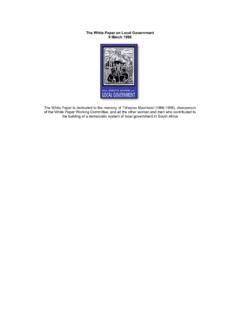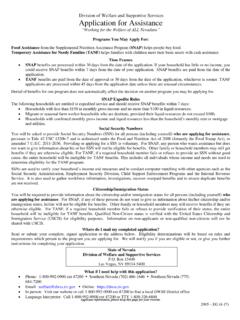Transcription of HOUSEHOLD FOOD INSECURITY IN CANADA - PROOF
1 2017 2018 Valerie Tarasuk and Andy MitchellHOUSEHOLDFOOD INSECURITYIN CANADAA cknowledgmentsThis report is a PROOF initiative supported by the Canadian Institutes of Health Research grant PJT 153260 and the Joannah and Brian Lawson Centre for Child Nutrition at the University of Toronto. The authors are indebted to Stephanie Vasko, Sarah Anne Charlebois, and Niveen Saleh from the Canadian Observatory on Homelessness for their layout and design work on the report. Hub Solutions is a social enterprise embedded within the Canadian Observatory on Homelessness (COH).
2 Income generated from Hub Solutions fee-for-service work is reinvested into the COH to support research, innovation, policy recommendations and knowledge mobilization. Learn more: to cite this document: Tarasuk V, Mitchell A. (2020) HOUSEHOLD food INSECURITY in CANADA , 2017-18. Toronto: Research to identify policy options to reduce food INSECURITY ( PROOF ). Retrieved from 2020 Research to identify policy options to reduce food INSECURITY ( PROOF )This research paper is protected under a Creative Commons license that allows you to share, copy, distribute, and transmit the work for non-commercial purposes, provided you attribute it to the original SummaryHousehold food INSECURITY refers to the inadequate or insecure access to food because of financial constraints.
3 food INSECURITY takes a serious toll on individuals health and well-being, and it places a significant burden on our health care system. Although there has been rigorous measurement and monitoring of HOUSEHOLD food INSECURITY in CANADA since 2005, there is little indication that this problem is getting better. Drawing on data for 103,500 households from Statistics CANADA s Canadian Community Health Survey conducted in 2017 and 2018, we found that of households experienced some level of food INSECURITY in the previous 12 months.
4 There were million people, including more than million children under the age of 18, living in food -insecure households in 2017-18. This is higher than any prior national INSECURITY is much more prevalent in Nunavut than any other part of CANADA . In 2017-18, of households in Nunavut reported some level of food INSECURITY and almost half of these households were severely food insecure. The prevalence of food INSECURITY was also high in Northwest Territories, at The lowest prevalence of HOUSEHOLD food INSECURITY was in Quebec.
5 Quebec was the only place in CANADA where the prevalence of food INSECURITY fell significantly between 2015-16 and 2017-18. Among the 35 census metropolitan areas examined, food INSECURITY was most prevalent in St John s, affecting more than 1 in 6 households in this city. The lowest rate of food INSECURITY was in Quebec City, where 1 in 12 households was food INSECURITY BY PROVINCE & TERRITORYData Source: Statistics CANADA , Canadian Community Health Survey (CCHS), INSECURITY is more prevalent among households with children.
6 In 2017-18, of children under 18, or more than 1 in 6, lived in households that experienced food INSECURITY . Nunavut and the Northwest Territories had the highest prevalence of children living in food -insecure households at 79% and 30% respectively, but rates were also high in many provinces. About 1 in 5 children in Saskatchewan, Manitoba, Prince Edward Island, Nova Scotia, and New Brunswick lived in households reporting some food INSECURITY is closely related to other markers of social and economic disadvantage. It is most prevalent among households with low incomes, lone-parent families, those who rent rather than own their housing, and those who identify as Indigenous or Black.
7 In 2017-18, 65% of food -insecure households were reliant on employment incomes. Among those outside the workforce, food INSECURITY affected 60% of households reliant on social assistance, 32% of those reliant on Employment Insurance or Workers Compensation, and 7% of households reliant on pensions and retirement incomes. The persistently high prevalence of HOUSEHOLD food INSECURITY across CANADA highlights the need for more effective, evidence-based policy responses by the federal government to address the social and economic circumstances that give rise to this problem.
8 The differences in food INSECURITY rates across the provinces and territories also point to the important roles that provincial and territorial governments can play in protecting their populations from food in food -insecure householdsData Source: Statistics CANADA , Canadian Community Health Survey (CCHS), in 6 CHILDRENMost food -insecure households are in the workforce. 65% reported their main source of income as wages or salaries from For more information about HOUSEHOLD expenditure patterns in the context of HOUSEHOLD food INSECURITY , please see Fafard St-Germain & Tarasuk.
9 Prioritization of the essentials in the spending patterns of Canadian households experiencing food INSECURITY . Public Health Nutrition 2018;21(11):2065-78. doi: To learn about the relationship between food INSECURITY and people s abilities to afford prescription medications, see Men et al, CMAJ Open 2019. 2 This information comes from the results of several studies using data from CANADA s National Longitudinal Study of Children and Youth. See, for example, Kirkpatrick and McIntyre & Potestio. Child hunger and long-term adverse consequences for health.
10 Archives of Pediatrics and Adolescent Medicine 2010;164(8):754-62. McIntyre et al. The pervasive effect of youth self-report of hunger on depression over 6 years of follow up. Soc Psychiatry Psychiatr Epidemiol 2017;52 Canadian Community Health Survey (CCHS) in 2017-18 marks the first time since 2011-12 that the HOUSEHOLD food INSECURITY has been measured in every province and territory. Drawing on data from this survey, we present a portrait of HOUSEHOLD food INSECURITY in CANADA , examining who is most affected and how food INSECURITY rates differ across the country.






